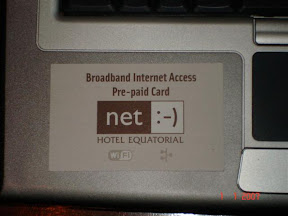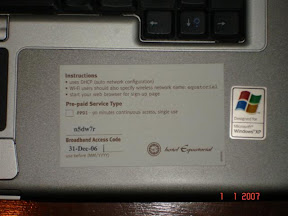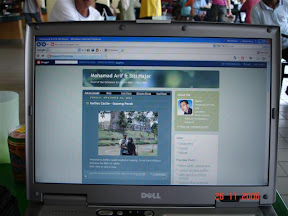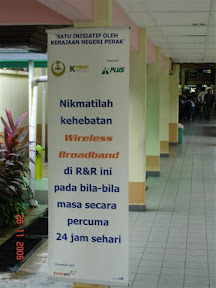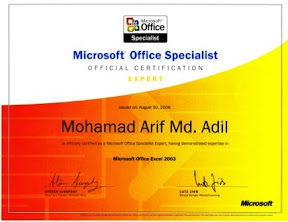.jpg) Should I repeat it again. As you can see from the flyer sent by PIKOM, it is all about the events where you can get anything that is related to ICT. So mark your calendar and visit the event site nearest to you.
Should I repeat it again. As you can see from the flyer sent by PIKOM, it is all about the events where you can get anything that is related to ICT. So mark your calendar and visit the event site nearest to you.Wednesday, March 21, 2007
PIKOM PC Fair 2007
.jpg) Should I repeat it again. As you can see from the flyer sent by PIKOM, it is all about the events where you can get anything that is related to ICT. So mark your calendar and visit the event site nearest to you.
Should I repeat it again. As you can see from the flyer sent by PIKOM, it is all about the events where you can get anything that is related to ICT. So mark your calendar and visit the event site nearest to you.Wednesday, March 14, 2007
MIEL IT ED 2007 - Microsoft Powerpoint 2003 Part Two
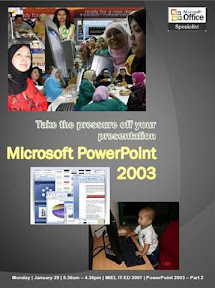
My first Training Session that I conducted for this new year 2007. Focused on the followings:-
- Use Navigation for Editing Slides
- Use Navigation during Slide Show
- Use a Printing Option
- Operate and Handle a Presentation Media such as Multimedia Projecter etc.
Chargeable WiFi Internet Access @ Equatorial Hotel, Cameron Highlands
Nice Hotel to stay and it is truth it was naturally coolest. Got WiFi access with a cost of RM9.90 for 90 minutes. Ehmm... since this is my fourth time stayed in this hotel, this newly improvement things is very much in favour.
MIEL IT ED 2006 - Website and Weblog Which One Do You Prefer?
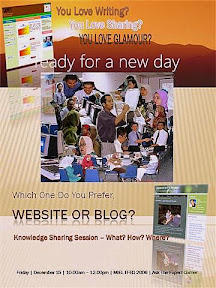
A Talk on Website and Blog for MIEL staff which was speakered by me. During this session the participant will get to know more about what is all about Website and Blog. Focus on free web and blog hosting provider template and resources. Credited to Tripod.Lycos.com and Blogger.com in providing such user friendly website.
Interesting topics to highlights in future.
MIEL IT ED 2006 - Microsoft Powerpoint 2003 Part One
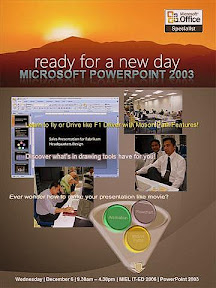
My Third Training Session that I have conducted for staff of MIEL Bhd. Focus on Creating a Flowchart using Drawing Tools, Introduction to Animation, and Custom Animation which included Motion Path in Microsoft PowerPoint 2003. To sharpen my knowledge and skills after acquired MOS 2003.
Free WiFi Internet Access at KLIA (Kuala Lumpur International Airport)
Location: Kuala Lumpur International Airport (KLIA)
Availability: Anytime & Snailing
Signal Strength: -90dBm
SSID: TMNET
WiFi@KLIA
WiFi is available in KLIA both at Arrival & Departure Hall. The bandwidth connection quite dissapointed. It connects at a relatively snail's pace of 11Mbps. After all it takes about RM9 for a parking ticket charge for me while waiting for uploading one entry of my family blog. For those people who have a laptop or PDA why not surf the NET for free.
Free WiFi Internet Access @ Tapah PLUS Rest Area
Location: PLUS Tapah Rest Area (Both Towards North and South)
Availability: Anytime and Reliable
Signal Strength: -70dBm
SSID: TMNET
WiFi HotSpot at Tapah Rest Area. Surf the Net for free when you are travelling to North on Project Lebuhraya Utara Selatan (PLUS) Highway. At least it is worthwhile for you to pay for the excessive Toll Rate.
Availability: Anytime and Reliable
Signal Strength: -70dBm
SSID: TMNET
WiFi HotSpot at Tapah Rest Area. Surf the Net for free when you are travelling to North on Project Lebuhraya Utara Selatan (PLUS) Highway. At least it is worthwhile for you to pay for the excessive Toll Rate.
Microsoft Office Specialist Certification?
The official Microsoft Office certification for desktop productivity, it is the premier credential chosen by individuals seeking to validate their skills and advance their careers. Known as a globally recognized standard demonstrating skills with Microsoft Office Applications.
Seated for the exam at Stamford College Petaling Jaya, Selangor. Certifications Granted to me:
i) Microsoft Office Excel 2003 Specialist Expert
ii) Microsoft Office PowerPoint 2003 Specialist
Information Technology Dilemma Towards Business Values
It's no secret that Information Technology (IT) accountability should be based on business objectives, not just technology metrics like network uptime. Yet many organizations have a tough time to relate overall IT performance measurement level toward business value. Over the past several years, companies have become disillusioned with technology that did not deliver business value. If companies cannot find such a balance, they risk limiting their ability to respond to market changes. Other departments have clear targets to aim for. The Human Resources (HR) department commonly uses employee satisfaction surveys to help judge the effectiveness of its objectives. While IT department offer statistics about system uptime, downtime, and idle CPU cycles. These metrics only reveal the operational health of IT assets rather than the strategic value IT has to offer to the corporation as a whole.1 Historically, performance measurement systems for most businesses have been financial in nature. Since our Prime Minister Dato’ Seri Abdullah Ahmad Badawi stress on BSC and KPI, an increasing number of organizations are adopting the Balanced Scorecard framework customized to the needs of the IT Department. The Balanced Scorecard is not a static list of measures, but a framework for implementing and aligning complex programs of change within strategy-focused organizations. In contrast, the primary goal of Balanced Scorecard metrics is to help drive and monitor the implementation of strategy.2 Typically, the IT department can use the balanced scorecard approach to assess the impact of the organization’s business strategy (e.g., entering a new business line or product category) on the existing IT portfolio. It can further determine how the IT organization can align itself to support the organization’s overall objectives. The Balanced Scorecard breaks down strategy into initiatives that have relevance to day-to-day activities. Further, it facilitates resource allocation based on both immediate performance and long-term value. For example, in the past, people hesitated to suggest new ideas because it meant more work for them. In other cases, the ideas were forgotten by the next staff meeting. Today, IT executives collectively decide whether they should follow an idea based on how well it fits with the goals and objectives defines in their IT Balanced Scorecard. If the group does not consider it to be an immediate fit, it gets put into the parking lot for future consideration. Another important best-practice is the use of cross-functional steering committees, in which both business and IT takes responsibility for setting priorities and discussing IT expenditures. These meetings help align business and IT objectives by tackling controversial issues such as how best to allocate the budget.3 According to Management Guru Peter Drucker, IT departments need to step back from their internal focus and strive to define their roles within the organization. Instead of focusing on “doing things right, “they should concentrate on “doing the right things “if they are to help create business value for their organizations.4 A word of caution here? In spite of capturing multiple perspectives, the balanced scorecard must still retain a strong emphasis on financial outcomes if the tool is to be accepted by senior management. In fact, according to Kaplan and Norton, if a company’s improved operation performance fails to get converted into overall improved financial performance, the managers responsible for the balanced scorecard should rethink the company’s strategy or its implementation plans.5 It takes a significant amount of time to implement the Balanced Scorecard properly. Hopefully with the objectives defined in the Balanced Scorecard will helps IT to fulfill its proper role as a change agent in today’s competitive marketplace. This continual realignment with the objectives of other departments creates a solid framework to drive the overall progress of the company.6
References:
1) Pushpak Sarkar, “Applying the Balanced Scorecard in the IT Organization”, DM Review Magazine, December 2003
2) Susan H. Cramm, “Balancing Scorecards With Reality”, CIO Magazine, December 2004
3) Tim Miner, “Measuring IT Value”, Infosys.Com, October 2003
4) Peter F. Drucker, “The Next Information Revolution”, Forbes, August 1998
5) Robert S. Kaplan & David P. Norton, “The Balanced Scorecard – Measures That Drive Performance”, Harvard Business Review, Jan-Feb 1992
6) Graham Waller, “The CIO as a Change Agent”, CIO Magazine, November 2004
Subscribe to:
Posts (Atom)
Blog Archive
-
▼
2007
(18)
-
▼
March
(9)
- PIKOM PC Fair 2007
- MIEL IT ED 2007 - Microsoft Powerpoint 2003 Part Two
- Chargeable WiFi Internet Access @ Equatorial Hotel...
- MIEL IT ED 2006 - Website and Weblog Which One Do ...
- MIEL IT ED 2006 - Microsoft Powerpoint 2003 Part One
- Free WiFi Internet Access at KLIA (Kuala Lumpur In...
- Free WiFi Internet Access @ Tapah PLUS Rest Area
- Microsoft Office Specialist Certification?
- Information Technology Dilemma Towards Business Va...
-
▼
March
(9)
